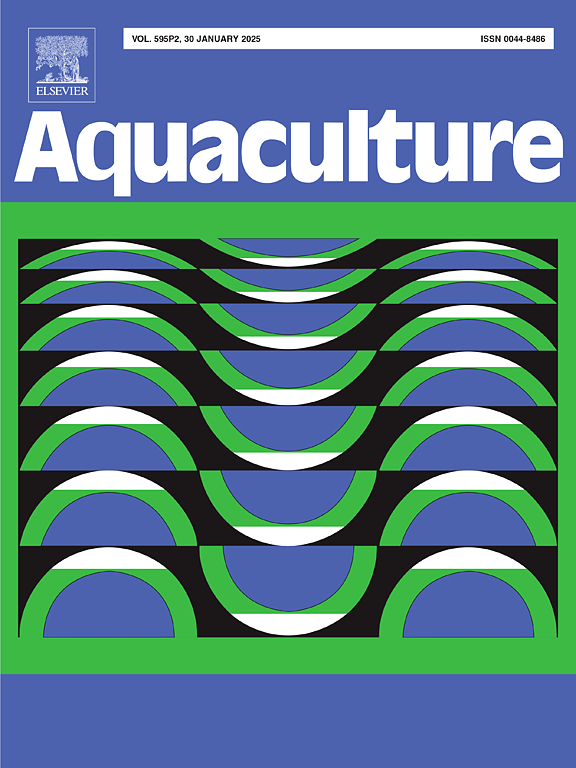Efficacy, non-target impacts, and costs of mechanical control options against a bioturbator in bivalve aquaculture
IF 3.9
1区 农林科学
Q1 FISHERIES
引用次数: 0
Abstract
Bivalve aquaculture benefits from non-chemical, operational-scale pest management tools to sustain or increase production. Mechanical methods to control a bioturbating pest (burrowing shrimp Neotrypaea californiensis) have been tested in Washington State (USA), providing a roadmap for other regions affected by native or widespread pests. These shrimp smother and bury ground-cultured oysters on tidal flats even when the shrimp are at low densities. Therefore, control methods with high efficacy are required, also considering non-target effects and costs to implement. From 2002 to 2023, 55 mechanical control trials were carried out, plus two shell-addition trials from earlier research. Methods included: 1) surface barriers, 2) shrimp removal, 3) sediment disruption, and 4) physical conditions intended to cause direct mortality (e.g. electricity, heat). Data were compiled through a meta-analysis framework, in which effect size was calculated as the log response ratio of treated relative to reference plots. Most surface barriers were not effective because they were penetrated by shrimp or insufficiently anchored; an exception was application of five inches (12.7 cm) of gravel. Shrimp removal was effective with a water-jet technique developed to collect shrimp for bait at low tide, but efforts to deploy multiple jets with a towed mechanized device were unsuccessful. Sediment disruption through surface compaction was the most common farm-scale approach but insufficiently reduced shrimp densities, whereas consolidating sediment with vibration to 1 m depth had high efficacy but has been applied only in small plots. Effect sizes were not available for any field trials of direct mortality methods, but energy required to kill shrimp was calculated from laboratory studies (1–50 kW-hr m−3 in water, and higher energy required in saturated sediment). Across all field methods, efficacy improved with effort (person-hours per area). Sediment showed reduced penetrability and increased muddiness following treatment. Non-target effects on infauna included both positive and negative effect sizes, consistent with a community change following a reduction in shrimp density. In the six studies measuring epibenthic species, no overall positive response to control of shrimp occurred, even though the reason for control is to protect surface-dwelling species from bioturbation by shrimp. This outcome illustrates the importance of pairing efficacy in terms of reduction of shrimp and improvement of farming. The vertical position of N. californiensis below nearly a meter of water-saturated sediment, along with an innate tolerance to pressure and anoxia, has placed them out of reach of most attempted mechanical methods. Although progress has been made in recent years, mechanical control options remain limited that can be carried out without permits and that economically reduce shrimp to densities compatible with benthic shellfish aquaculture at a farm scale.
双壳贝类水产养殖中针对生物扰动器的机械控制方案的功效、非目标影响和成本
双壳类水产养殖受益于非化学、操作规模的害虫管理工具,以维持或提高产量。在美国华盛顿州测试了控制生物扰动害虫(穴居虾 Neotrypaea californiensis)的机械方法,为其他受本地或广泛害虫影响的地区提供了路线图。即使在虾的密度较低时,这些虾也会窒息和掩埋潮滩上地面养殖的牡蛎。因此,需要高效的控制方法,同时考虑到非目标影响和实施成本。从 2002 年到 2023 年,共进行了 55 次机械控制试验,加上早期研究中的两次贝壳添加试验。方法包括1) 表面屏障;2) 虾类移除;3) 沉积物破坏;4) 物理条件,旨在造成直接死亡(如电、热)。通过荟萃分析框架对数据进行了汇编,其中效果大小是以处理地块与参照地块的对数反应比来计算的。大多数地表障碍物都没有效果,因为它们被虾穿透或锚定不够;使用 5 英寸(12.7 厘米)的砾石是个例外。为在退潮时收集虾作为诱饵而开发的喷水技术能有效清除虾,但使用拖曳式机械装置部署多个喷水装置的努力并不成功。通过表面压实来扰乱沉积物是最常见的养殖规模方法,但不足以降低虾的密度,而用振动将沉积物压实到 1 米深的方法效果很好,但只在小地块中应用过。任何直接杀虾方法的实地试验都没有效果大小,但根据实验室研究计算出了杀虾所需的能量(在水中为 1-50 kW-hr m-3,在饱和沉积物中需要更高的能量)。在所有现场方法中,效率随着努力(每区域人时)的增加而提高。沉积物在处理后的穿透性降低,浑浊度增加。对底栖生物的非目标影响包括正效应和负效应,这与虾密度降低后的群落变化一致。在测量底栖物种的六项研究中,尽管控制虾的原因是保护表栖物种免受虾的生物扰动,但控制虾并没有产生整体的积极反应。这一结果说明,在减少对虾和改善养殖方面,配对效果非常重要。加利福尼亚虾的垂直位置低于近一米的水饱和沉积物,加上对压力和缺氧的天生耐受性,使其无法使用大多数尝试过的机械方法。尽管近年来取得了一些进展,但机械控制方法仍然有限,而且这些方法无需许可即可实施,并能经济地将虾的密度降低到与底栖贝类养殖规模相适应的程度。
本文章由计算机程序翻译,如有差异,请以英文原文为准。
求助全文
约1分钟内获得全文
求助全文
来源期刊

Aquaculture
农林科学-海洋与淡水生物学
CiteScore
8.60
自引率
17.80%
发文量
1246
审稿时长
56 days
期刊介绍:
Aquaculture is an international journal for the exploration, improvement and management of all freshwater and marine food resources. It publishes novel and innovative research of world-wide interest on farming of aquatic organisms, which includes finfish, mollusks, crustaceans and aquatic plants for human consumption. Research on ornamentals is not a focus of the Journal. Aquaculture only publishes papers with a clear relevance to improving aquaculture practices or a potential application.
 求助内容:
求助内容: 应助结果提醒方式:
应助结果提醒方式:


